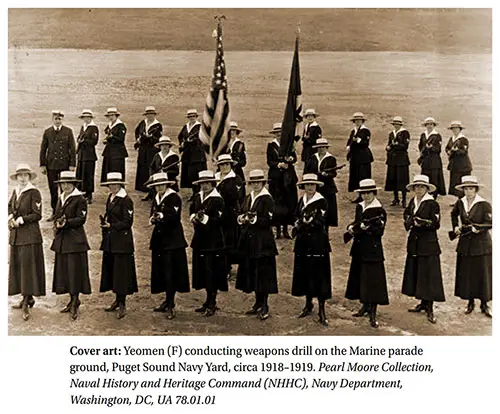USN First Enlisted Women: Introduction - 2019

Yeomen (f) Conducting Weapons Drill on the Marine Parade Ground, Puget Sound Navy Yard, circa 1918-1919. Pearl Moore Collection, Naval History and Heritage Command (NHHC), Navy Department, Washington, DC, UA 78.01.01. The Navy's First Enlisted Women, 2019. GGA Image ID # 1981d11777
I am honored to contribute The Navy’s First Enlisted Women: Patriotic Pioneers to the Naval History and Heritage Command’s (NHHC) commemoration publications for World War I. These women’s loyalty, selflessness, professionalism, and patriotism are exemplary and can inspire today’s naval personnel, especially the females who stand on their shoulders. Women have volunteered to serve their nation during every war or conflict since the American Revolution.
The female yeomen continued this legacy and remained focused despite strong criticism. The Navy operated more efficiently and effectively with them.
Some forces within the Navy and Congress tried to prevent these amazing women from receiving the recognitions they earned following the war. However, with the help of the American Legion, naval officers, and other advocates, the female veterans continued their fight to be recognized.
Chapter 1 considers the contradiction between the United States’ engaging in a war to protect democracy while denying democratic rights and privileges to women and blacks. It also provides a brief overview of the history of women in the military prior to the United States’ entry into World War I.
The second chapter describes Secretary of the Navy Josephus Daniels’s decision to recruit women, the enlistment process, and their “basic training.”
The third chapter analyzes how the various clerical and non-clerical duties of the yeomen (F.) contributed directly to the success of the Navy’s strategy and the Allied victory, as well as gender relations.
The fourth chapter explores how the war changed the world, their lives, and the Navy.
The epilogue summarizes key changes in the status of Navy women since World War I.
The select list of sources will help those desiring further study. This pamphlet also provides photographs and citations throughout its text that are all in the public domain.
World War I histories tend to minimize, marginalize, or ignore the multiple roles of civilian and military women. Some authors have helped to fill this gap such as Lettie Gavin’s American Women in World War I; Kimberly Jensen’s Mobilizing Minerva: American Women in the First World War; and Susan Godson’s Serving Proudly: A History of Women in the U.S. Navy. Evelyn M. Monahan and Rosemary Neidel-Greenlee’s A Few Good Women: America’s Military Women from World War I to the Wars in Iraq and Afghanistan; Eunice C. Dessez’s The First Enlisted Women 1917–1918; and Jean Ebbert and Marie-Beth Halls’ studies Crossed Currents: Navy Women from World War I to Tailhook, and The First, The Few, The Forgotten are also noteworthy.
The Navy’s First Enlisted Women: Patriotic Pioneers is intended to elevate the historical discussion and enrich the available literature on women’s military service. There is much more research to be done on the roles of American women in World War I especially on the contributions of African Americans, Hispanics, Native Americans, and other people of color.
Their patriotism in the face of blatant racism, discrimination and Jim Crowism is commendable and deserves more scholarly attention.
The National Archives and Records Administration released the World War I veterans’ official service records at the National Military Personnel Records Center in St. Louis, Missouri, without restriction, making an extremely valuable source available. Related primary documents can be accessed via the websites for many archives.
Historians, documentary editors, film directors, and others launching projects relating to the history of the Great War tend to include little about military women.
Too many scholars do not recognize the utilization of women as a personnel readiness issue. When asked about the decision to exclude or minimize women’s participation, some explain that they are not doing social history.
Many scholars referred to history about women as social history until the 1970s. A paradigm shift is needed. Producers, historians, webmasters, museum curators, and others interpreting history can, and should, make a greater effort to be more comprehensive while expanding our knowledge of the war.
Those looking for subjects for their documentary, dissertation, thesis, or article need look no further. My hope is that this history educates, entertains, and engages readers and motivates them to learn more about these outstanding women.
May it also raise new questions about the yeomen (F.)’s experiences and give readers a greater appreciation for their World War I service and sacrifice.
Finally, I believe readers will be inspired by the female yeomen’s patriotism and contributions. The conclusions presented are mine and do not necessarily represent the Department of Defense or any component thereof. I am responsible for any errors therein. —
Regina T. Akers, Ph.D., "Introduction," in The Navy’s First Enlisted Women: Patriotic Pioneers to the Naval History, Washington, DC: Naval History and Heritage Command, 2019.
